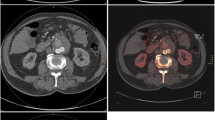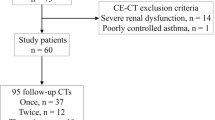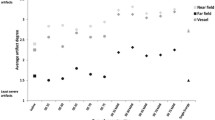Abstract
Objectives
To assess the diagnostic accuracy of dual-energy computed tomography (DECT) for detection of endoleaks and aneurysm sac calcifications after endovascular aneurysm repair (EVAR) using hard plaque imaging algorithms.
Materials and methods
One hundred five patients received 108 triple-phase contrast-enhanced CT (non-contrast, arterial and delayed phase) after EVAR. The delayed phase was acquired in dual-energy and post-processed using the standard (HPI-S) and a modified (HPI-M) hard plaque imaging algorithm. The reference standard was determined using the triple-phase CT and contrast-enhanced ultrasound. All images were analysed separately for the presence of endoleaks and calcifications by two independent readers; sensitivity, specificity and interobserver agreement were calculated.
Results
Endoleaks and calcifications were present in 25.9 % (28/108) and 20.4 % (22/108) of images. The HPI-S images had a sensitivity/specificity of 54 %/100 % (reader 1) and 57 %/99 % (reader 2), the HPI-M images of 93 %/92 % (reader 1) and 96 %/92 % (reader 2) for detection of endoleaks. For detection of calcifications HPI-S had a sensitivity/specificity of 91 %/99 % (reader 1) and 95 %/97 % (reader 2), the HPI-M images of 91 %/99 % (reader 1) and 91 %/99 % (reader 2), respectively.
Conclusion
Using HPI-M, DECT enables an accurate diagnosis of endoleaks after EVAR and allows distinguishing between endoleaks and calcifications with high diagnostic accuracy.
Key Points
• Dual-energy computed tomography allows the diagnosis of aortic pathologies after EVAR.
• Hard plaque imaging algorithms can distinguish between endoleaks and aneurysm sac calcifications.
• The modified hard plaque imaging algorithm detects endoleaks with high diagnostic accuracy.





Similar content being viewed by others
Abbreviations
- CEUS:
-
Contrast-enhanced ultrasound
- DECT:
-
Dual-energy computed tomography
- EVAR:
-
Endovascular aneurysm repair
- HPI (S/M):
-
Hard plaque imaging (standard/modified)
- MMWP:
-
Multimodality workplace
- VNC:
-
Virtual non-contrast
References
Prinssen M, Verhoeven EL, Buth J et al (2004) A randomized trial comparing conventional and endovascular repair of abdominal aortic aneurysms. N Engl J Med 351:1607–1618
Keith CJ, Passman MA, Gaffud MJ et al (2013) Comparison of long-term outcomes following endovascular repair of abdominal aortic aneurysms based on size threshold. J Vasc Surg. doi:10.1016/j.jvs.2013.06.060
Golzarian J, Valenti D (2006) Endoleakage after endovascular treatment of abdominal aortic aneurysms: Diagnosis, significance and treatment. Eur Radiol 16:2849–2857
Jones JE, Atkins MD, Brewster DC et al (2007) Persistent type 2 endoleak after endovascular repair of abdominal aortic aneurysm is associated with adverse late outcomes. J Vasc Surg 46:1–8
Stavropoulos SW, Charagundla SR (2007) Imaging techniques for detection and management of endoleaks after endovascular aortic aneurysm repair. Radiology 243:641–655
Rozenblit AM, Patlas M, Rosenbaum AT et al (2003) Detection of endoleaks after endovascular repair of abdominal aortic aneurysm: value of unenhanced and delayed helical CT acquisitions. Radiology 227:426–433
Stolzmann P, Frauenfelder T, Pfammatter T et al (2008) Endoleaks after endovascular abdominal aortic aneurysm repair: detection with dual-energy dual-source CT. Radiology 249:682–691
Sommer WH, Graser A, Becker CR et al (2010) Image quality of virtual noncontrast images derived from dual-energy CT angiography after endovascular aneurysm repair. J Vasc Interv Radiol 21:315–321
Genant HK, Boyd D (1977) Quantitative bone mineral analysis using dual energy computed tomography. Invest Radiol 12:545–551
Millner MR, McDavid WD, Waggener RG et al (1979) Extraction of information from CT scans at different energies. Med Phys 6:70–71
Buerke B, Wittkamp G, Seifarth H et al (2009) Dual-energy CTA with bone removal for transcranial arteries: intraindividual comparison with standard CTA without bone removal and TOF-MRA. Acad Radiol 16:1348–1355
Chae EJ, Kim N, Seo JB et al (2013) Prediction of postoperative lung function in patients undergoing lung resection: dual-energy perfusion computed tomography versus perfusion scintigraphy. Invest Radiol 48:622–627
Mangold S, Thomas C, Fenchel M et al (2012) Virtual nonenhanced dual-energy CT urography with tin-filter technology: determinants of detection of urinary calculi in the renal collecting system. Radiology 264:119–125
Glazebrook KN, Guimarães LS, Murthy NS et al (2011) Identification of intraarticular and periarticular uric acid crystals with dual-energy CT: initial evaluation. Radiology 261:516–524
Chandarana H, Godoy MC, Vlahos I et al (2008) Abdominal aorta: evaluation with dual-source dual-energy multidetector CT after endovascular repair of aneurysms-initial observations. Radiology 249:692–700
Numburi UD, Schoenhagen P, Flamm SD et al (2010) Feasibility of dual-energy CT in the arterial phase: Imaging after endovascular aortic repair. Am J Roentgenol 195:486–493
Maturen KE, Kleaveland PA, Kaza RK et al (2011) Aortic endograft surveillance: use of fast-switch kVp dual-energy computed tomography with virtual noncontrast imaging. J Comput Assist Tomogr 35:742–746
Ascenti G, Mazziotti S, Lamberto S et al (2011) Dual-energy CT for detection of endoleaks after endovascular abdominal aneurysm repair: usefulness of colored iodine overlay. Am J Roentgenol 196:1408–1414
Acknowledgments
The scientific guarantor of this publication is C. Dornia. The authors of this manuscript declare relationships with the following companies: B. Krauss is an employee of Siemens AG, Healthcare Sector, Germany. The remaining authors of this manuscript declare no relationships with any companies, whose products or services may be related to the subject matter of the article. The authors state that this work has not received any funding. F. Zeman kindly provided statistical advice for this manuscript. Institutional Review Board approval was obtained. Written informed consent was obtained from all subjects (patients) in this study. No study subjects or cohorts have been previously reported. Methodology: prospective, diagnostic or prognostic study, performed at one institution.
Author information
Authors and Affiliations
Corresponding author
Additional information
R. Müller-Wille and T. Borgmann both contributed equally.
Rights and permissions
About this article
Cite this article
Müller-Wille, R., Borgmann, T., Wohlgemuth, W.A. et al. Dual-energy computed tomography after endovascular aortic aneurysm repair: The role of hard plaque imaging for endoleak detection. Eur Radiol 24, 2449–2457 (2014). https://doi.org/10.1007/s00330-014-3266-y
Received:
Revised:
Accepted:
Published:
Issue Date:
DOI: https://doi.org/10.1007/s00330-014-3266-y




